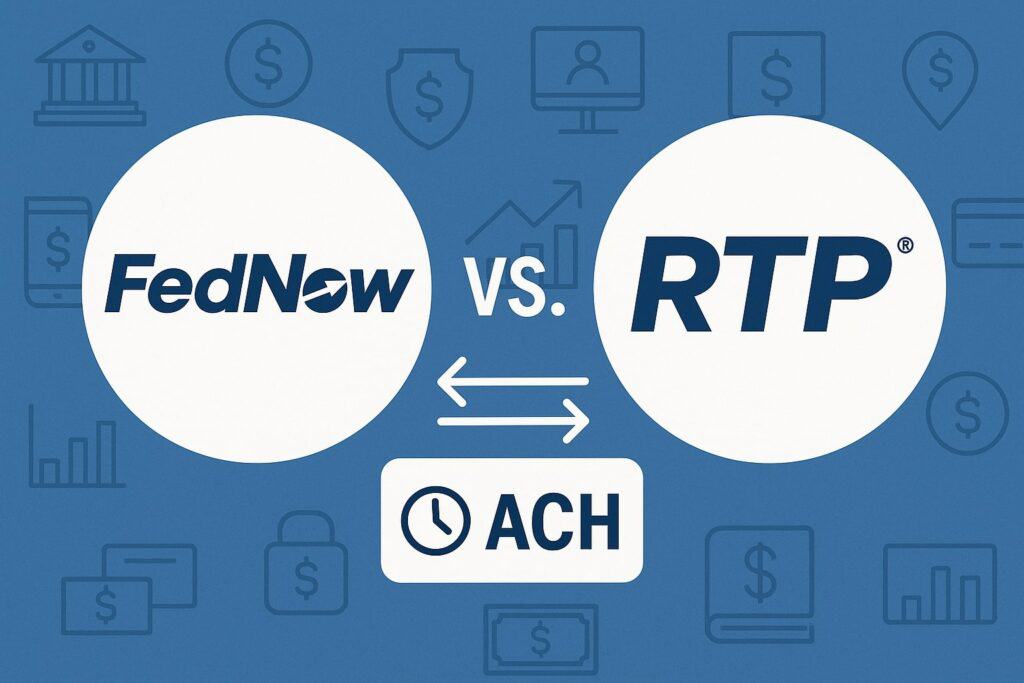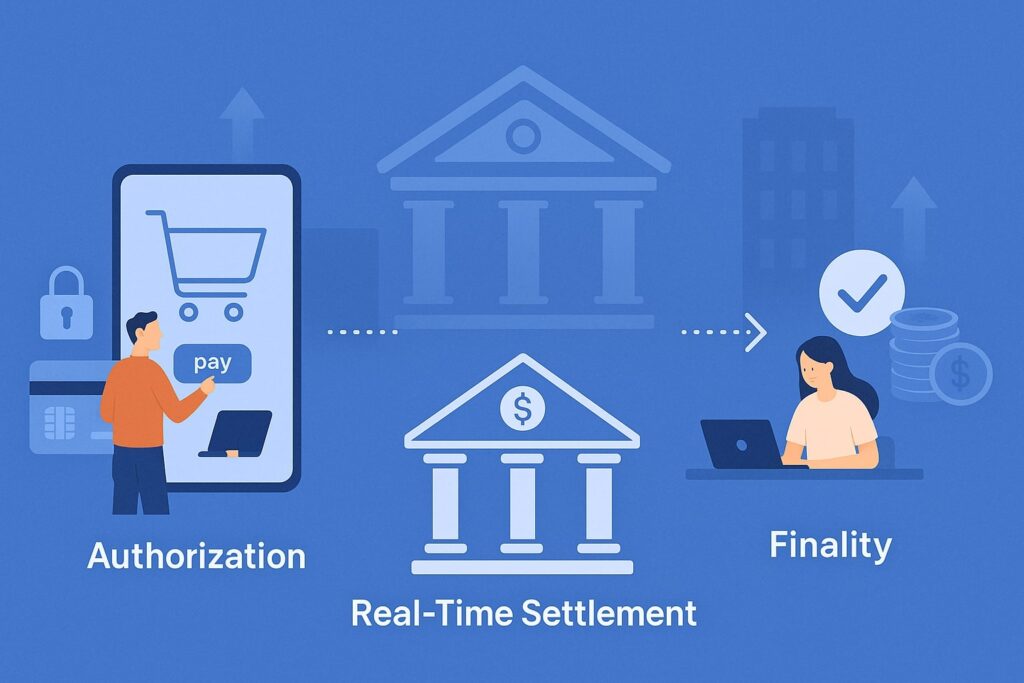
Understanding Payment Settlement in Real Time
“Payment settlement in real time” describes the instant movement of funds and confirmation of finality between payer and payee—24x7x365, in seconds, with immediate funds availability. In the U.S., this capability has moved from pilot projects to production rails used daily by banks, credit unions, platforms, and merchants.
Two domestic instant payment networks—The Clearing House RTP® network and the Federal Reserve’s FedNow® Service—deliver true real-time settlement, while Same Day ACH offers same-day speed for use cases that don’t require second-level finality.
For U.S. businesses, the benefits are tangible: stronger cash flow, fewer reversals, richer remittance data, and better customer experiences.
This guide breaks down how payment settlement in real time works, where it differs from “fast” but non-instant methods, what risks to manage, and how to adopt real-time payments (RTP) and FedNow without disrupting operations.
You’ll also learn the latest U.S. updates—like higher instant payment limits and ISO 20022 data changes—so you can make informed decisions. If you’re a CFO, controller, payments lead, or platform operator, this is your latest, U.S.-focused, and practical walkthrough of payment settlement in real time and how to put it to work.
What “Payment Settlement in Real Time” Really Means in the U.S.

When we talk about payment settlement in real time, we mean irrevocable clearing and settlement that completes in seconds, 24x7x365, with immediate funds availability to the receiver’s account.
In the U.S., that’s what the RTP® network and the FedNow® Service provide. Both are credit-push systems: the sender authorizes their financial institution (FI) to push funds; there are no pulls that could bounce later.
The transaction includes confirmations back to both institutions, and finality means the receiver can use the funds right away—no waiting for nightly batches or next business day postings.
By contrast, debit cards, wires, or ACH may be “fast” in user experience but don’t always guarantee instant, irrevocable settlement with immediate availability.
Key practical distinctions matter. First, availability: instant rails run 24x7x365 including weekends and holidays; ACH and wires follow business-day calendars and cutoffs.
Second, risk posture: because instant payments settle in real time, there’s no float and essentially no chargebacks in the card sense—so risk controls must shift to front-of-funnel authorization and fraud decisioning.
Third, data quality: modern real-time payment messages carry ISO 20022 structured data, which supports richer remittance and straight-through reconciliation.
The bottom line: payment settlement in real time isn’t just “faster funding.” It’s a different rail with different rules that can simplify receivables, compress DSO, and unlock new customer experiences—if you implement it thoughtfully.
Load-bearing facts: FedNow is designed for seconds-level, 24x7x365 processing with immediate availability; RTP provides real-time, 24×7 credit transfers.
The U.S. Real-Time Rails: FedNow® vs. RTP® (and Where Same Day ACH Fits)

In the U.S., two instant rails are available: RTP® (operated by The Clearing House, live since 2017) and FedNow® (operated by the Federal Reserve, launched 2023). Both deliver payment settlement in real time with immediate availability and ISO 20022 messaging.
Practically, many banks are onboard to one or both rails. RTP historically had the head start with broader early coverage among large banks; FedNow broadened its reach via the Federal Reserve’s network of participants. If your FI supports both, a payment hub can route the transaction to the reachable counterparty rail.
Where does Same Day ACH fit? It’s not instant and not 24x7x365. Same Day ACH batches clear multiple times per business day; funds can post the same day subject to windows and bank posting policies.
It’s perfect when “same day” is good enough, for payroll adjustments, bill pay, or B2B where second-level finality isn’t mandatory. But if a marketplace needs to pay gig workers at midnight Sunday, or a title company must disburse proceeds immediately, payment settlement in real time via RTP or FedNow is the better match.
Load-bearing facts: FedNow runs 24x7x365 with immediate funds availability; Same Day ACH provides faster ACH with scheduled windows; RTP raised its per-payment limit to $10M in 2025.
2025 Updates That Matter: Limits, Schedules, and ISO 20022 Data
Transaction limits are rising. As of February 9, 2025, RTP® increased its single payment limit to $10 million, up from $1 million—expanding high-value use cases like real estate, supply chain, and B2B treasury payments.
Early data from The Clearing House indicates significant growth in high-value activity since the increase. Meanwhile, the FedNow® Service has operated with a $1 million maximum; the Federal Reserve announced an increase to $10 million effective November 2025, aligning the cap with RTP for parity across many corporate scenarios.
These shifts are pivotal because ceilings often dictated whether “instant” could replace wires for larger, time-sensitive payments.
Scheduling and operating windows also continue evolving outside the instant rails. Same Day ACH maintains multiple business-day processing windows, and Nacha has explored adding more flexibility—including industry discussion of a fourth window and better same-day returns usage by RDFIs.
For teams still reliant on ACH for certain flows, tracking these windows and funds-availability policies remains critical.
Data modernization matters just as much as speed. U.S. instant rails use ISO 20022 structured messages, improving invoice references, remittance details, and reconciliation.
Globally, the November 2025 milestone for SWIFT CBPR+ ISO 20022 “end of coexistence” raises the bar for cross-border messaging quality, which indirectly benefits U.S. firms by harmonizing formats across counterparties and banks.
FedNow’s ISO 20022 foundation means richer data travels with the payment, not in out-of-band PDFs or emails.
How Real-Time Settlement Works End-to-End (From Authorization to Finality)

A typical payment settlement in real time journey begins when the payer initiates a credit transfer from their bank or app.
The sending bank authenticates the customer (KYC already completed at onboarding), evaluates risk and fraud signals in milliseconds, and—if approved—sends the ISO 20022 message into the instant rail (RTP or FedNow).
The rail performs scheme-level validations and routes the payment to the receiving bank. The receiving bank confirms the account is valid, runs its own compliance and fraud checks, posts the credit, and returns a confirmation.
All of this is completed in seconds, with irrevocable settlement: both banks now have a synchronized view, and the receiver has immediate funds availability.
Two practical consequences follow. First, no chargebacks in the card sense—real-time credit transfers are final, which eliminates downstream operational costs of disputes but elevates the importance of front-end controls.
Second, rich remittance data accompanies the payment: invoice numbers, PO references, or unique IDs that allow straight-through reconciliation without manual keying. For developers, idempotency keys and real-time webhooks align internal ledgers with bank confirmations.
For finance, instant confirmations allow immediate release of goods, instant account crediting for sellers, and intraday liquidity decisions based on real balances—not estimates.
Load-bearing facts: Instant rails provide immediate availability and seconds-level processing; richer data via ISO 20022 reduces errors and improves remittance detail quality.
Benefits for U.S. Businesses: Cash Flow, Cost, and Customer Experience
Adopting payment settlement in real time can transform cash-flow operations. With RTP or FedNow, funds are usable immediately, allowing you to shorten Days Sales Outstanding (DSO), pay suppliers on delivery, and offer instant payouts to contractors, sellers, or claimants—on weekends and holidays.
Treasury teams get true intraday visibility and can optimize working capital by initiating or delaying payments precisely when needed. For marketplaces and gig platforms, instant payouts are a powerful acquisition and retention lever; for field services, “pay now, job done” flows reduce collection friction and charge-off risk.
Cost and risk profiles can improve. Real-time transfers can replace wires for many high-value payments (especially with the $10M cap on RTP and the pending $10M cap on FedNow in Nov 2025), often at lower fees with better automation.
Rich ISO 20022 data supports automatic matching to invoices, cutting exceptions work. There’s no card interchange and no card chargeback handling.
On the risk side, because settlement is final, you shift investment to preventive controls: strong customer authentication, beneficiary validation, device and behavioral biometrics, and account name checks.
The customer experience gets a lift, too: confirmations in seconds, tracking of payment status end-to-end, and consistency—24x7x365, every day of the year.
Load-bearing facts: RTP limit at $10M (Feb 2025); FedNow $10M effective Nov 2025; FedNow and RTP are always-on with immediate availability.
Key Risks and How to Control Them in Real-Time Environments
With payment settlement in real time, the security perimeter moves upstream. Because payments are irrevocable, you must stop bad payments before they’re sent.
Start with layered identity proofing at onboarding (document verification, database checks, and device fingerprinting), then add step-up authentication for high-value or risky flows (WebAuthn/passkeys, OTP with phishing-resistance, or app-based approvals).
Implement beneficiary confirmation—e.g., name/number matching where available—and set payment velocity and value thresholds that require additional review for outliers. Real-time behavioral analytics can flag unusual session patterns (new device, late-night high-value transfer to a first-time payee).
Compliance and fraud teams should tune transaction monitoring for instant rails, where “time to detect” is near-zero. Configure real-time alerting and define stop/allow rules your orchestration can apply instantly.
Educate customers to recognize social-engineering tactics (imposter CFO, fake vendor banking details, urgent after-hours requests). For B2B, formalize out-of-band verification for bank detail changes.
Finally, plan incident response: even with finality, rapid contact between counterpart banks, the rail operator, and law enforcement can sometimes freeze or recover funds when the receiving account is still within the banking system and cooperative controls exist—speed and documentation matter.
Comparing Rails by Use Case: Instant vs. Same Day vs. Traditional
- Instant (RTP/FedNow): Best when you require immediate funds availability and finality any time—e.g., real-estate disbursements, marketplace seller payouts, earned-wage access, insurance claims, supplier pre-shipment releases, or emergency vendor payments outside business hours.
With the $10M caps (RTP live; FedNow announced for Nov 2025), high-value corporate payments increasingly fit, reducing reliance on wires for many treasury workflows. - Same Day ACH: Ideal for same-day but not instantaneous needs: payroll off-cycles, bill payments, B2B transactions that benefit from batch processing, or when counterparties aren’t reachable on instant rails.
You’ll plan around ACH windows and posting policies. Nacha’s schedules and funds-availability charts are essential references for operations teams and processors. - Traditional ACH & Wires: Traditional ACH remains strong for scheduled, lower-cost batch payments where next-day crediting is acceptable.
Wire transfers still fit very high-value or special-handling scenarios (e.g., cross-border via SWIFT, escrow-controlled closings) and may include bank-to-bank arrangements not yet mirrored on instant rails.
But as limits rise and reach expands across payment settlement in real time, many wires can migrate, cutting fees and manual reconciliation.
Implementation Roadmap: How a U.S. Business Goes Live with Real-Time Settlement
- Assess use cases and value: Rank flows by urgency, payment value, required data, and customer impact. Typical first wins: seller payouts, on-demand disbursements, just-in-time supplier payments, and refunds where positive experience matters.
- Choose an access model: Work with your primary bank (or multiple banks) for RTP/FedNow access, or integrate through a payments platform/processor that already supports both rails. Prioritize reach (how many counterparties your FI can hit), SLAs, and reporting.
- Design data and reconciliation: Map ISO 20022 fields to your ERP/GL. Decide your unique payment references and structure remittance to enable automated matching. Align real-time webhooks or bank statement files with your internal ledger events.
- Build risk and compliance controls: Calibrate KYC/KYB, sanctions screening, and real-time fraud scoring. Define transaction limits and step-up criteria. Create playbooks for beneficiary changes and callback verification.
- Engineer the customer experience: Show real-time statuses (“sent,” “confirmed,” “available”), provide instant receipts, and clearly label cutoff differences between instant vs. ACH. Offer request for payment (RfP) where supported to reduce entry errors.
- Pilot, monitor, iterate: Launch with a contained segment, monitor exception codes, and expand once STP exceeds targets. Update routing logic to prefer instant rails when counterparties are reachable; fall back to ACH when not.
- Educate finance & support: Train AP/AR and customer support on finality, dispute handling (no card-style chargebacks), and how to troubleshoot payment settlement in real time events versus ACH/wire flows.
The Role of ISO 20022: Why Data Quality Is the Hidden Superpower
Speed grabs headlines, but data wins the back office. ISO 20022 lets you embed structured remittance information into each instant payment—invoice IDs, references, discounts, and even line-item context depending on the schema.
That means automatic, rules-based matching in your ERP, fewer short-pays, and reduced exceptions. For CFOs, the combination of payment settlement in real time and high-fidelity data produces daily cash positions that are actually accurate. For auditors, event traces are richer and easier to follow.
2025 is a pivotal year: the November 2025 milestone on the cross-border SWIFT network (CBPR+) pushes global counterparties to the new standard, making it easier for U.S. firms dealing with international suppliers to align formats.
FedNow’s native ISO 20022 design already gives domestic businesses a head start—expect fewer manual reconciliations and faster month-end close as adoption grows. If you’re scoping a project, involve both your payments engineers and your ERP owners early to harmonize message fields, reference structures, and error handling.
Governance, Compliance, and Operations for Always-On Payments
Operating 24x7x365 changes the organizational playbook. You’ll need around-the-clock monitoring (or at least on-call rotations) for rails health, webhook processing, and exception handling.
Access controls should reflect higher risk for admin actions that can alter routing rules or beneficiary master data; use least privilege and strong MFA. Refresh your Business Continuity and Disaster Recovery (BC/DR) plans to include instant rails: failovers, duplicate notification handling, and idempotency checks.
On the compliance side, ensure BSA/AML models and sanctions screening can evaluate real-time transactions with low latency. Document your consumer disclosures if you offer instant payouts to individuals (fees, availability, error resolution). Align retention and audit trails with regulatory expectations.
Finally, because payment settlement in real time compresses detection windows, focus on preventive controls, automated monitoring, and analytics that surface anomalies immediately, rather than overnight.
Load-bearing fact: FedNow and RTP are designed for uninterrupted 24x7x365 processing, which influences staffing and monitoring models.
Real-World Scenarios: Where Instant Settlement Shines
- Real estate and escrow disbursements: With $10M instant limits, disbursing sale proceeds or clearing liens no longer requires waiting for wire windows. Title companies can release funds instantly with auditable confirmations, even after hours or on weekends (RTP live; FedNow limit increase effective Nov 2025).
- Supplier enablement and JIT inventory: Manufacturers can release exact-amount payments when goods hit the dock, reducing safety stock. Suppliers see funds immediately, improving working capital and loyalty.
- Marketplaces and gig platforms: Sellers and workers can cash out instantly, improving NPS and retention while reducing card-payout costs. ISO 20022 references per transfer align payouts to orders or shifts for smooth reconciliation.
- Insurance claims and healthcare refunds: Paying claimants instantly reduces call volume and improves CSAT; structured data tags the claim ID to the payment for automated posting.
- Finance and treasury ops: With payment settlement in real time, treasury can sweep or fund accounts anytime, minimize trapped liquidity, and replace many wires with lower-cost instant transfers.
Future Trends: Reach, Request-to-Pay, and Smarter Routing
Expect expanding reachability as more community banks and credit unions enable receive (and send) capabilities on both rails. Request-for-Payment (RfP) will gain traction for billers and AR teams to request an exact amount from customers, cutting entry errors and late payments.
Smart routing engines will decide in real time which rail to use based on counterparty, limit, fee, and SLA—falling back to Same Day ACH when instant isn’t reachable. As ISO 20022 analytics mature, businesses will apply machine learning to remittance data to forecast cash positions and predict disputes.
Regulators and operators continue to evolve the ecosystem—Nacha has examined additional Same Day ACH windows and operational guidance; The Clearing House and the Federal Reserve continue enhancing instant services, including higher limits and network features.
Keep an eye on program changes that affect payment settlement in real time, such as new fraud-mitigation tools, expanded message sets, or liquidity features for institutions.
FAQs
Q.1: What’s the difference between “instant,” “real-time,” and “same-day” settlement?
Answer: “Instant” and “real-time” typically refer to the same outcome in the U.S.: credit transfers that clear and settle in seconds with immediate funds availability—24x7x365—on rails like RTP and FedNow.
These payments are irrevocable, so fraud controls must be applied before sending. “Same-day” refers to Same Day ACH, which is faster than standard ACH but still batched, limited to business-day windows, and subject to bank posting practices.
Same Day ACH can be enough for payroll adjustments, B2B bill payments, or situations that don’t require second-level finality.
If your business needs instant disbursement or must release goods upon receipt, payment settlement in real time is the right fit. Instant rails also carry ISO 20022 structured data that improves reconciliation, while ACH formats vary.
For many high-value U.S. payments in 2025, the higher $10M limits on RTP (already live) and FedNow (announced for Nov 2025) expand where instant can replace wires.
Q.2: Are real-time payments safe, and how do I manage fraud without chargebacks?
Answer: Yes—payment settlement in real time is secure by design, but the risk model changes. Because transfers are final, you must strengthen front-of-funnel defenses.
Combine strong onboarding (document checks, device profiling), step-up authentication for high-risk events, beneficiary name checks, velocity controls, sanctions screening, and behavioral analytics that evaluate risk in milliseconds.
Train staff and customers against social engineering (CEO fraud, vendor bank-detail swaps), enforce out-of-band callbacks for first-time or high-value beneficiaries, and log events for rapid investigations.
Compared with cards, you avoid interchange and classic chargebacks, but you must invest in pre-transaction controls and real-time monitoring to stop fraud before the payment leaves. Both RTP and FedNow run 24x7x365, so align your staffing, alerts, and escalation paths accordingly.
Q.3: How do rising limits affect my decision to use RTP or FedNow versus wires?
Answer: Limits determine whether instant rails can replace wires for a given transaction. As of February 9, 2025, RTP supports up to $10 million per transaction, which already unlocks many treasury and B2B scenarios previously constrained to wires.
The Federal Reserve has announced a FedNow limit increase to $10 million effective November 2025. If your payments fit under these caps and your counterparties are reachable, instant rails can offer lower costs, richer data, 24×7 availability, and straight-through reconciliation—often with less manual work than a wire.
For amounts above the caps or special cases (e.g., certain cross-border flows), wires may still be appropriate. Talk to your bank about reachability, fees, and routing logic so your system automatically chooses the optimal rail.
Conclusion
Payment settlement in real time is no longer a future promise—it’s a production-grade capability U.S. businesses can deploy today for instant, irrevocable, data-rich payments, 24x7x365.
With higher transaction limits on RTP (live at $10M) and FedNow (announced for Nov 2025), many high-value, time-sensitive flows can move off wires to instant rails, cutting costs and cycle time.
Meanwhile, ISO 20022 data improves reconciliation and unlocks operational efficiency. To capture the benefits, align technology (bank or processor access, ISO mappings, webhooks), finance (cash-flow policies, DSO targets), and risk (front-end controls, real-time monitoring, education).
Start with high-impact use cases—seller payouts, supplier releases, claim disbursements—and scale with smart routing across rails. The businesses that treat payment settlement in real time as a strategic capability will operate with sharper cash visibility, stronger customer experiences, and a durable edge in the modern U.S. payments landscape.